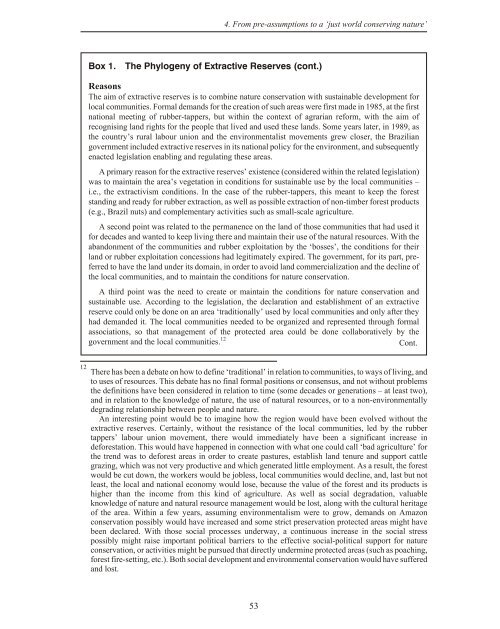The Protected Landscape Approach - Centre for Mediterranean ...
The Protected Landscape Approach - Centre for Mediterranean ...
The Protected Landscape Approach - Centre for Mediterranean ...
Create successful ePaper yourself
Turn your PDF publications into a flip-book with our unique Google optimized e-Paper software.
4. From pre-assumptions to a ‘just world conserving nature’<br />
Box 1.<br />
<strong>The</strong> Phylogeny of Extractive Reserves (cont.)<br />
Reasons<br />
<strong>The</strong> aim of extractive reserves is to combine nature conservation with sustainable development <strong>for</strong><br />
local communities. Formal demands <strong>for</strong> the creation of such areas were first made in 1985, at the first<br />
national meeting of rubber-tappers, but within the context of agrarian re<strong>for</strong>m, with the aim of<br />
recognising land rights <strong>for</strong> the people that lived and used these lands. Some years later, in 1989, as<br />
the country’s rural labour union and the environmentalist movements grew closer, the Brazilian<br />
government included extractive reserves in its national policy <strong>for</strong> the environment, and subsequently<br />
enacted legislation enabling and regulating these areas.<br />
A primary reason <strong>for</strong> the extractive reserves’ existence (considered within the related legislation)<br />
was to maintain the area’s vegetation in conditions <strong>for</strong> sustainable use by the local communities –<br />
i.e., the extractivism conditions. In the case of the rubber-tappers, this meant to keep the <strong>for</strong>est<br />
standing and ready <strong>for</strong> rubber extraction, as well as possible extraction of non-timber <strong>for</strong>est products<br />
(e.g., Brazil nuts) and complementary activities such as small-scale agriculture.<br />
A sec ond point was re lated to the per ma nence on the land of those com mu ni ties that had used it<br />
<strong>for</strong> de cades and wanted to keep liv ing there and main tain their use of the nat u ral re sources. With the<br />
aban don ment of the com mu ni ties and rubber ex ploi ta tion by the ‘bosses’, the con di tions <strong>for</strong> their<br />
land or rub ber ex ploi ta tion con ces sions had le git i mately ex pired. <strong>The</strong> gov ern ment, <strong>for</strong> its part, pre -<br />
ferred to have the land un der its do main, in or der to avoid land com mer cia li zation and the de cline of<br />
the lo cal com mu ni ties, and to main tain the conditions <strong>for</strong> nature conservation.<br />
A third point was the need to create or maintain the conditions <strong>for</strong> nature conservation and<br />
sustainable use. According to the legislation, the declaration and establishment of an extractive<br />
reserve could only be done on an area ‘traditionally’ used by local communities and only after they<br />
had demanded it. <strong>The</strong> local communities needed to be organized and represented through <strong>for</strong>mal<br />
associations, so that management of the protected area could be done collaboratively by the<br />
government and the local communities. 12<br />
Cont.<br />
12 <strong>The</strong>re has been a debate on how to define ‘traditional’ in relation to communities, to ways of living, and<br />
to uses of resources. This debate has no final <strong>for</strong>mal positions or consensus, and not without problems<br />
the definitions have been considered in relation to time (some decades or generations – at least two),<br />
and in relation to the knowledge of nature, the use of natural resources, or to a non-environmentally<br />
degrading relationship between people and nature.<br />
An interesting point would be to imagine how the region would have been evolved without the<br />
extractive reserves. Certainly, without the resistance of the local communities, led by the rubber<br />
tappers’ labour union movement, there would immediately have been a significant increase in<br />
de<strong>for</strong>estation. This would have happened in connection with what one could call ‘bad agriculture’ <strong>for</strong><br />
the trend was to de<strong>for</strong>est areas in order to create pastures, establish land tenure and support cattle<br />
grazing, which was not very productive and which generated little employment. As a result, the <strong>for</strong>est<br />
would be cut down, the workers would be jobless, local communities would decline, and, last but not<br />
least, the local and national economy would lose, because the value of the <strong>for</strong>est and its products is<br />
higher than the income from this kind of agriculture. As well as social degradation, valuable<br />
knowledge of nature and natural resource management would be lost, along with the cultural heritage<br />
of the area. Within a few years, assuming environmentalism were to grow, demands on Amazon<br />
conservation possibly would have increased and some strict preservation protected areas might have<br />
been declared. With those social processes underway, a continuous increase in the social stress<br />
possibly might raise important political barriers to the effective social-political support <strong>for</strong> nature<br />
conservation, or activities might be pursued that directly undermine protected areas (such as poaching,<br />
<strong>for</strong>est fire-setting, etc.). Both social development and environmental conservation would have suffered<br />
and lost.<br />
53

















